This document summarizes Peter Bloom's 1984 paper on the "2-Sigma Problem" regarding effective teaching of large groups. Bloom's study found that average students taught one-on-one (tutoring) performed 2 standard deviations above students in conventional large lectures (2-Sigma). Students in "Mastery Learning" classes, with formative testing, performed 1 standard deviation higher. The document then lists alterable educational variables by their effect size on student performance, with tutoring and feedback having the largest impact. Bloom aimed to solve the 2-Sigma problem by combining variables, though no single combination achieved tutoring levels of performance.
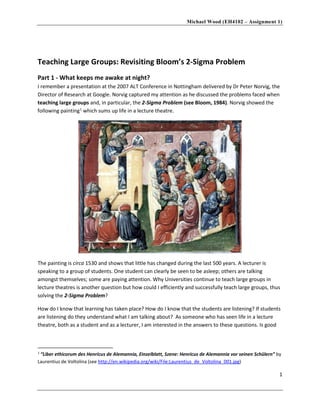
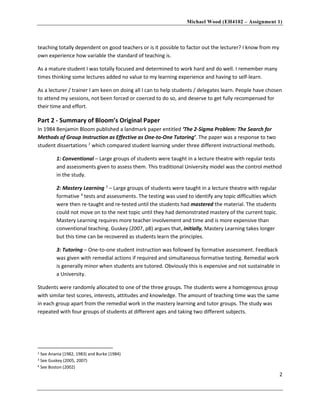
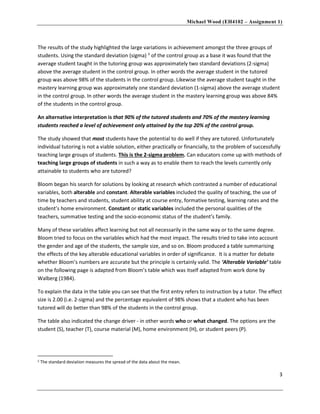
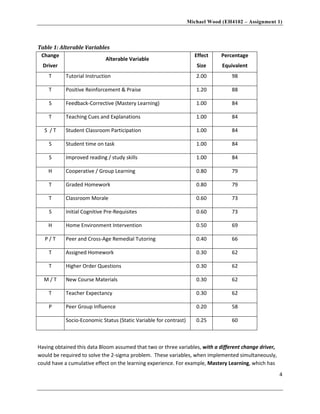
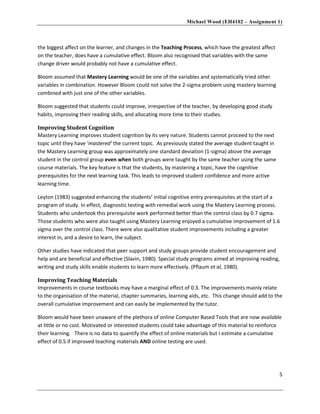

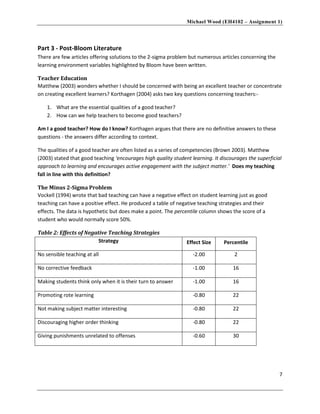
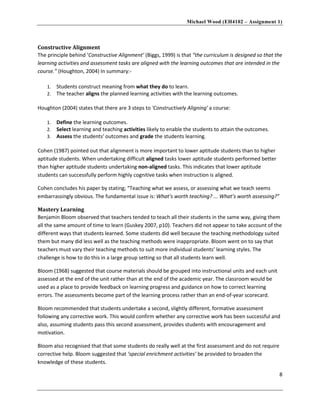
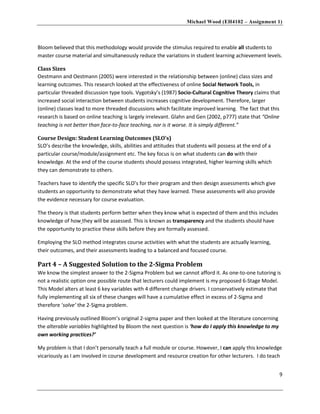

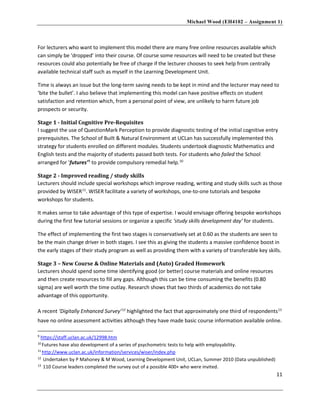


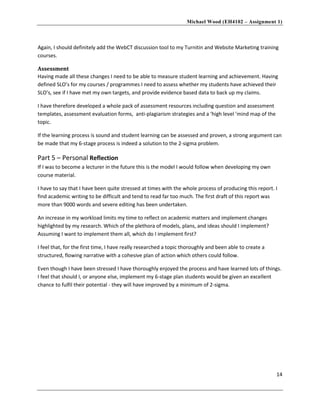
![Michael Wood (EH4102 – Assignment 1)
15
Bibliography
Alexander, B. (2008) Social Networking in Higher Education. In: Katz, R. (ed.) The Tower and the Cloud.
EduCause: Available from: http://net.educause.edu/ir/library/pdf/PUB7202s.pdf [Accessed 13th
December 2010]
Anania, J. (1982) The effects of quality of instruction on the cognitive and affective learning of students.
Dissertation Abstracts International, 42, 4269A.
Anania, J. (1983) The influence of instructional conditions on student learning and achievement.
Evaluation in Education: An International Review Series, 7(1), 1 – 92
Biggs, J. (1999) Teaching for Quality Learning at University. SRHE and Open University Press,
Buckingham
Bloom, B. (1968) Learning for mastery. Evaluation Comment, 1(2), 1–12. (ERIC Document Reproduction
No. ED053419)
Bloom, B. (1984) The 2 Sigma Problem: The Search for Methods of Group Instruction as Effective as One-
to-One Tutoring. Educational Researcher, 13(6), 4 – 16
Boston, C. (2002) The Concept of Formative Assessment. Practical Assessment, Research & Evaluation;
8(9). Available from: http://PAREonline.net/getvn.asp?v=8&n=9 [Accessed 21st
July 2010]
Brophy, J. & Good, T. (1970) Teachers’ communication of differential expectations for children’s
classroom performance: Some behavioural data. Journal of Educational Psychology, 61, 365 – 374
Brown, S. (2003) Differentiating good and excellent teaching: is it possible? Exchange 5, 32. Available
from: http://www.exchange.ac.uk [Accessed 4th
November 2010]
Burke, A. (1984) Students’ potential for learning under tutorial and group approaches to instruction.
Dissertation Abstracts International, 44, 2025A.
Cohen, S. (1987) Instructional Alignment: Searching for a Magic Bullet. Educational Researcher, 16(8) 16
– 20
Combs, A., Blume, R., Newman, A., and Wass, H.; (1974) The professional education of teachers: A
humanistic approach to teacher preparation. Boston: Allyn & Bacon
Dave, R. (1963) The identification and measurement of environment process variables that are related to
educational achievement. Unpublished Thesis, University of Chicago](https://image.slidesharecdn.com/69c099e5-6818-4666-8bda-1a6818231226-151118112915-lva1-app6891/85/2_Sigma_Problem_Mick_Wood-15-320.jpg)
![Michael Wood (EH4102 – Assignment 1)
16
Gallop, A (2005) Ageing Population Conference 2005: Sixty-Five and Not Out! An Age of Opportunity or
Limitation? Demographic Data Pack - 7-9 September 2005, St Anne’s College, Oxford, UK
Glahn, R. and Gen, R. (2002) Progenies in education: The evolution of internet teaching. Community
College Journal of Research and Practice. 26, 777 – 785
Guskey, T. (2005) Formative Classroom Assessment and Benjamin S. Bloom: Theory, Research, and
Implications. Paper presented at the Annual Meeting of the American Educational Research Association
(Montreal, Canada, April 11-15, 2005) Available from: http://www.eric.ed.gov/ (ERIC # ED490412),
[Accessed 10th
June 2010]
Guskey, T. (2007) Closing the achievement gap: Revisiting Benjamin S. Bloom’s “learning for mastery”.
Journal of Advanced Academics, 19(1), 8 – 31
Houghton, W. (2004) Constructive Alignment - and why it is important to the learning process.
Engineering Subject Centre Guide: Learning and Teaching Theory for Engineering Academics.
Loughborough: HEA Engineering Subject Centre. (Available from: http://www.engsc.ac.uk/learning-and-
teaching-theory-guide/constructive-alignment [Accessed 26th November 2010]
James, R., McInniss, I. and Devlin, M. (2002) Assessing Learning in Australian Universities. Centre for the
Study for Higher Education. Available from:
http://www.cshe.unimelb.edu.au/assessinglearning/docs/AssessingLearning.pdf [Accessed 18th
November 2010]
Korthagen, F. (2004) In search of the essence of a good teacher: towards a more holistic approach in
teacher education. Teaching and Teacher Education, 20, 77 – 97
Leyton, F. (1983) The extent to which group instruction supplemented by mastery of the initial cognitive
prerequisites approximates the learning effectiveness of one-to-one tutorial methods. Dissertation
Abstracts International, 44, 974A.
Lowyck, J. (1978) Process Analysis of Teaching Behaviour. Leuven: Leuven University
Matthew, R. (2003) Excellent Teaching or Excellent Learning? Exchange, 5, 30 – 31. Available from:
http://www.exchange.ac.uk [Accessed 4th
November 2010]
Oestmann, E. & Oestmann, J. (2005) Significant Differences in Learning Outcomes and Online Class Size.
Journal of Online Educators, 2(1). Available from:
http://www.oeinet.org/LEARNING%20OUTCOMES%20&%20CLASS%20SIZE.doc [Accessed 10th
June
2010]
Pflaum, S., Walberg, H., Karegianes, M., & Rasher, S. (1980) Reading instruction: A Quantitative
Synthesis. Educational Researcher. 9, 12 – 18](https://image.slidesharecdn.com/69c099e5-6818-4666-8bda-1a6818231226-151118112915-lva1-app6891/85/2_Sigma_Problem_Mick_Wood-16-320.jpg)
![Michael Wood (EH4102 – Assignment 1)
17
Race, P. (2006) Making Teaching Work; Presentation made at Tralee Institute. Available from:
http://www.ittralee.ie/en/InformationFor/Staff/TeachingandLearningUnit/WorkshopandReports/PhilRa
cePresentation/filedownload,10961,en.pdf [Accessed 17th
November 2010]
Slavin, R. (1980) Cooperative Learning; Review of Educational Research, 50, 315 – 342
Vockell, E.(1994) The Minus Two-Sigma Problem: Correcting Defective Instruction. Contemporary
Education, 65(4), 185 – 190
Vygotsky, L.; (1987) Thinking and Speech: The Collected Works of L. S. Vygotsky. New York: Plenum
Walberg, H. (1984) Improving the Productivity of America's Schools. Educational Leadership, 41(8). 19 –
27](https://image.slidesharecdn.com/69c099e5-6818-4666-8bda-1a6818231226-151118112915-lva1-app6891/85/2_Sigma_Problem_Mick_Wood-17-320.jpg)